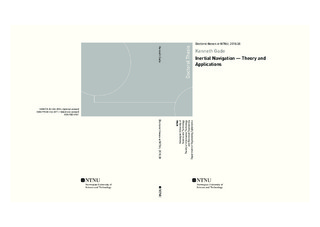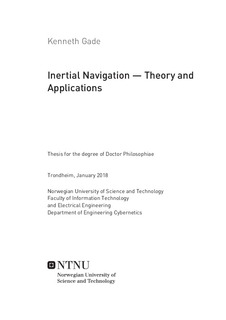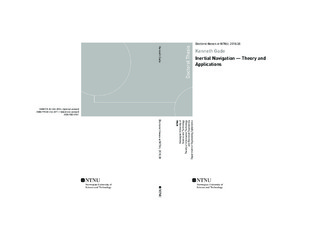| dc.contributor.author | Gade, Kenneth | |
| dc.date.accessioned | 2018-03-22T12:33:37Z | |
| dc.date.available | 2018-03-22T12:33:37Z | |
| dc.date.issued | 2018 | |
| dc.identifier.isbn | 978-82-326-2871-1 | |
| dc.identifier.issn | 1503-8181 | |
| dc.identifier.uri | http://hdl.handle.net/11250/2491714 | |
| dc.description.abstract | Navigation is defined as the process of estimating the six degrees of freedom. We have seen an increased demand for navigation the last decade, and important reasons for the growth are the increased availability of low cost inertial measurement units (IMUs) and global navigation satellite system (GNSS) receivers, and the increased use of autonomous vehicles.
When working with navigation in general, and when designing and implementing navigation systems in particular, a precise notation system is of utmost importance. Kinematical quantities such as velocity, acceleration, orientation, and angular velocity must be unambiguously specified both in documentation and program code. Five properties of a good notation system are identified, and a notation system fulfilling these properties is presented. The notation system includes a usage of sub- /superscripts that follow simple rules when the equations are correct, and hence the system contributes strongly to correct deductions and implementations. The sub- /superscripts and unambiguousness also lead to better understanding of quantities such as linear velocity, and misunderstandings/errors during exchange of code and/or equations are greatly reduced.
Position calculations are a central part of any navigation system, and common concerns are imprecise calculations (e.g. when using an ellipsoidal Earth model or when using map projections), complex implementations, and singularities. In addition, separating the horizontal and vertical position is often desirable. By representing horizontal position with the normal vector to the Earth ellipsoid (called n-vector) this separation is kept, while avoiding common problems with other such representations, e.g. the singularities and discontinuity of latitude/longitude and the distortion of map projections. Further, since the n-vector is a 3D vector, the powerful vector algebra can be used to solve many calculations intuitively and with few code lines. A code library solving many of the most common position calculations using n-vector has been made available for download (for several programming languages).
Estimating heading with sufficient accuracy is often the most challenging part when designing a low cost navigation system, and the necessary theory to support this task has not been available, making it even more challenging. A study of the theory behind heading estimation has thus been made, and based on this theory, different methods to find heading have been categorized by means of consistent mathematical principles. Using this categorization system, we have identified seven different methods to find heading for practical navigation systems. The methods are magnetic and gyrocompass, two methods based on observations, multiantenna GNSS, and two methods based on vehicle motion. With the aid of this theory and list of methods, designing navigation systems where heading is a challenge can now be done with full understanding and insight into the task. The possible ways to find heading for a given system are immediately identified, and no method is overlooked.
During navigation research and development, the support of appropriate software is vital. The aim to design one common software solution for a range of different navigation tasks was the motivation behind the development of a tool called NavLab. Important areas of usage include research and development, simulation studies, post-processing of logged sensor data, sensor evaluation, and decision basis for sensor purchase and mission planning. It has turned out that a generic design and implementation is feasible, and NavLab has been used to navigate a variety of different maritime, land and air vehicles. Users include research groups, commercial companies, military users and universities.
For underwater navigation, and in particular for autonomous underwater vehicles (AUVs), several different techniques have been used in NavLab to reduce the horizontal position estimation uncertainty. When feasible, the underwater vehicle can go to the surface for a GNSS fix, or be followed by a surface vehicle that combines GNSS with acoustic positioning and transmits the result. However, in practice an AUV must often handle long periods without position aid, and thus the drift of the core navigation system is of great importance. This core system often consists of an IMU and a Doppler velocity log (DVL), where the DVL is usually the most important sensor to limit the drift. In cases of DVL dropouts, the use of a vehicle model in the estimator significantly reduces the position drift, compared to a system in free inertial drift. This is the case even with high-end IMUs. For low-cost systems without a DVL, a vehicle model is vital, and it can also be used together with a DVL to improve the navigation system integrity.
Position drift can be avoided altogether by deploying one or more underwater transponders that provide range measurements to the underwater vehicle. We have developed a method where accurate position is estimated by means of only one single transponder. The method is implemented in NavLab, and it has demonstrated a position accuracy which is close to the performance achieved when the AUV is followed by a surface ship with acoustic positioning. | nb_NO |
| dc.language.iso | eng | nb_NO |
| dc.publisher | NTNU | nb_NO |
| dc.relation.ispartofseries | Doctoral theses at NTNU;2018:38 | |
| dc.relation.haspart | Paper 1:
Gade, Kenneth.
A non-singular horizontal position representation. Journal of navigation 2010 ;Volum 63.(3) s. 395-417
https://doi.org/10.1017/S0373463309990415 | |
| dc.relation.haspart | Paper 2:
Gade, Kenneth.
The Seven Ways to Find Heading. Journal of navigation 2016 ;Volum 69.(5) s. 955-970
https://doi.org/10.1017/S0373463316000096 | |
| dc.relation.haspart | Paper 3:
Gade, Kenneth; Jalving, Bjørn.
An Aided Navigation Post Processing Filter for Detailed Seabed Mapping. Modeling, Identification and Control 1999 ;Volum 20.(3) s. 165-176
https://doi.org/10.4173/mic.1999.3.2 | |
| dc.relation.haspart | Paper 4:
Gade, Kenneth.
NavLab, a Generic Simulation and Post-processing Tool for Navigation. Modeling, Identification and Control, vol. 26, no. 3, pp. 135-150
https://doi.org/10.4173/mic.2005.3.2 | |
| dc.relation.haspart | Paper 5:
Jalving, B., Gade, K., Hagen, O. K. and Vestgård, K. (2004). A Toolbox of
Aiding Techniques for the HUGIN AUV Integrated Inertial Navigation
System. Modeling, Identification and Control, vol. 25, no. 3, pp. 173-190.
https://doi.org/10.4173/mic.2004.3.3. | |
| dc.relation.haspart | Paper 6:
Jalving, Bjørn; Gade, Kenneth; Svartveit, Kristian; Willumsen, Are Baardsgaard; Sørhagen, Robert.
DVL Velocity Aiding in the HUGIN 1000 Integrated Inertial Navigation System. Modeling, Identification and Control 2004 ;Volum 25.(4) s. 223-236
https://doi.org/10.4173/mic.2004.4.2. | |
| dc.relation.haspart | Paper 7:
Hegrenæs, Øyvind; Hallingstad, Oddvar; Gade, Kenneth.
Towards model-aided navigation of underwater vehicles. Modeling, Identification and Control 2007 ;Volum 28.(4) s. 113-123
https://doi.org/10.4173/mic.2007.4.3. | |
| dc.relation.haspart | Paper 8:
Hegrenæs, Øyvind; Gade, Kenneth; Hagen, Ove Kent; Hagen, Per Espen.
Underwater Transponder Positioning and Navigation of Autonomous Underwater Vehicles. OCEANS Conference and Exhibition; 2009
https://doi.org/10.23919/OCEANS.2009.5422358 | |
| dc.title | Inertial Navigation — Theory and Applications | nb_NO |
| dc.type | Doctoral thesis | nb_NO |
| dc.subject.nsi | VDP::Teknologi: 500::Informasjons- og kommunikasjonsteknologi: 550::Teknisk kybernetikk: 553 | nb_NO |


